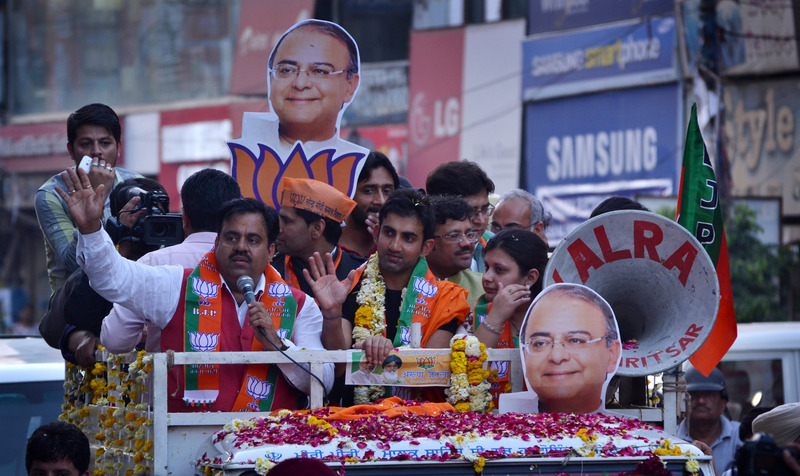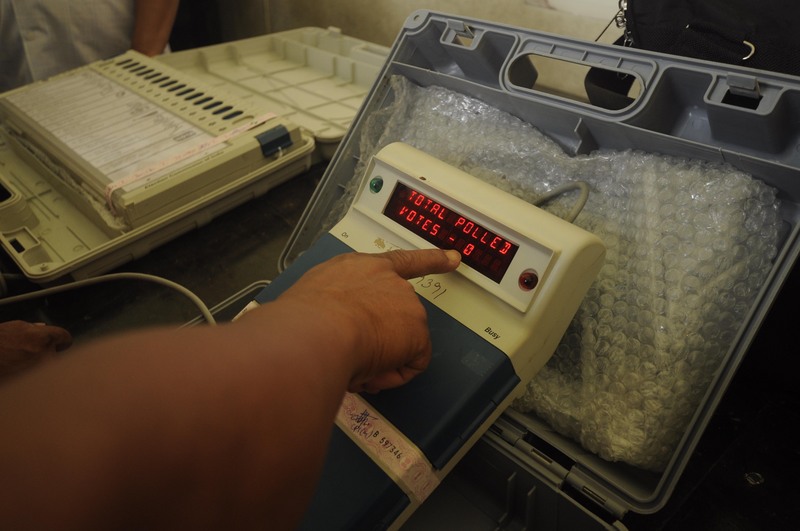India represents the largest democracy in the world [2]. The country has an asymmetric federal government [3], with elected officials at the federal, state and local levels. The head of government, the prime minister, is elected by the members of Lok Sabha [4], the lower house of parliament. Lok Sabha members are elected every five years, and this year's Lok Sabha elections, otherwise known as the Indian general elections 2014, kicks off today, April 7, 2014.
The world's biggest elections [5] are scheduled to run until 12 May 2014 in nine phases, during which voting will take place at about 930,000 polling stations throughout all the 543 parliamentary constituencies of India [6]. The results will be declared on 16 May 2014.
There are about 814.5 million voters, the most in the world, and nearly 100 million newly eligible voters have been added since the previous elections. The participating political parties are expected to spend about 5 billion US dollars on campaigns [7], the second highest in the world after the US elections. More than 10 million officials [8] including security forces will be deployed and 1.4 million electronic voting machines will be used for the election. But there are still challenges for people with disabilities [9] to participate in the elections due to lack of accessibility infrastructure.
The actors
The main contest [6] is between the National Democratic Alliance (NDA), United Progressive Alliance (UPA) and the Third Front. However, the main rivalry in this election will be between Narendra Modi [10], candidate for prime minister from the Bharatiya Janata Party-led National Democratic Alliance, and Rahul Gandhi [11], the vice president of the Indian National Congress party and the chairperson of the Indian Youth Congress and the National Students Union of India.
The Bharatiya Janata Party (BJP), led by Hindu nationalist Modi, and its allies are forecast [12] to win in majority of the constituencies, leaving behind the incumbent Congress party and its allies.
The elections are not without controversy. Modi is accused of failing to stop or even encouraging anti-Muslim riots in 2002 in the state of Gujarat, where he was chief minister. At least 1,000 people died in the violence, most of them Muslims. Modi denies the charges.
Almost one-fifth of candidates in India's upcoming general elections [13] face criminal charges including rape, murder and extortion. Religious violence has been predicted [14] during the elections.
Here are netizens’ take on the elections:
As of 12 Feb 2014, there are 1616 political parties registered with the Election Commission of India #IndiaElections [15]
— Atish Patel (@atishpatel) April 5, 2014 [16]
#India [17]: Opinion polls suggest that the business-friendly BJP is well on course to win the most seats in the national election.
— ETF alpha (@ETFalpha) April 6, 2014 [18]
800 Million People to vote over 5 weeks. Celebrating Democracy! Hoping this election brings in a change for a better INDIA. #IndiaElections [15]
— Vipul Agarwal (@Vipul20192) April 6, 2014 [19]
#YourVote2014 [20] is chance to finish corrupt and criminals from Parliament. Vote4AAP #CongBjpForeignFunded [21] pic.twitter.com/vU0DgZGQQi [22]
— bhavna sharma (@bhavna_india) March 28, 2014 [23]
Important stuff: NOTA (None of the Above) option will be used for the first time in Lok Sabha polls this year! #YourVote2014 [20]
— Nandini Bhalla (@nandinibhalla) March 5, 2014 [24]
Yup! RT @daddy_san [25]: I've gotta admit, @GulPanag [26] makes #Indian [27] election campaigning look cool and kickass. pic.twitter.com/Fb387uyH4A [28]” #Dabang [29]
— India Policy (@India_Policy) March 28, 2014 [30]
Elections on social media:
This year, more and more social media tools are being used for campaigning in India. The Washington Post reported [31] that Indian parties are using Obama-style campaign tactics to spread the words and woo voters. Candidates are using every gadget and platform – taking part in Google+ Hangouts, televised interviews organised on Facebook and using smart phone messaging app WhatsApp – to connect with millions of tech-savvy urban voters.
In India, Facebook has 93 million users [32] and Twitter has approximately 33 million accounts nationwide. Facebook and Twitter users will “wield a tremendous influence [33]” over the final results of the election, reported the Mumbai-based Iris Knowledge Foundation.
 [34]
[34]Indian cricketer Gautam Gambhir campaigns for Bharatiya Janata Party in Amritsar. Image by Sanjeev Syal. Copyright Demotix (5/4/2014)
Narendra Modi has 3.68 million followers on Twitter [35] and has attracted more than a million volunteers to his campaign. Rahul Gandhi is not tweeting personally [36] (although he has a fan-run account). Gandhi's Facebook page has more than 190,000 followers [37], while Modi has more than 12 million follower [38]s. Anti-corruption campaigner and former Chief Minister of Delhi Arvind Kejriwal has more than 1.5 million followers on Twitter.
Google India has introduced a Google Elections hub [39] in an attempt to encourage first-time voters and the growing number of Internet users in the country.
Google and Storyful have partnered [40] to build an Open Elections India Google+ community [41], a destination for citizen reporters and people monitoring the election to discover, verify, discuss and amplify content emerging from the social web during the general elections.
The women of India make up 49 percent of the electoral base, but women go to vote far less than their male counterparts [42]. Jaago Re [43] has initiated a social campaign called the Power of 49 to encourage more female voters to participate in the election.
Past Global Voices coverage:
20 Feb – Is Indian Anti-Corruption Leader Arvind Kejriwal's Resignation Clever or Crazy?
20 Jan – Despite Controversial Past, Indian PM Candidate Narendra Modi's Star on the Rise [46]
3 Jan – India's Aam Aadmi Party Wins Hearts and Forms Government in Delhi
15 Dec – Aam Admi Party Emerges As A Cleaner Option In Indian Politics [47]
Resources:
- 2014 Lok Sabha elections [48]
- List of candidates [49]
- Manifesto of different parties [50]
- Maps of constituencies [51]
- Google India Election Hub [52]
- India Decides: A Guide to the Elections and Beyond [53]
- India Votes: India's Largest Election Database [54]
- India Voting (for voter registration) [55]
- Official app of the Election Commission India [56] (for Windows Phone only)
- India Votes (opinion polls app for Windows phone) [57]
Hashtags:
#YourVote2014 [20]
#IndiaElections [58]
